The World of Worms
Reminder: Clicking on the picture will take you to the site where I originally found it.
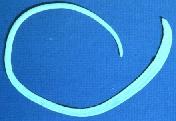 What can I say - this page is about worms. It's not always pleasant, not always exciting, but worms are animals too.
What can I say - this page is about worms. It's not always pleasant, not always exciting, but worms are animals too.
If you get over your squeamishness for a minute, you actually may find that worms are fun. They may surprise you in both abundance and diversity. Most are helpful to mankind, and some aren't even that slimy. I'm not saying there aren't nasty worms (from a human standpoint), but I'm just saying that maybe we should give worms a chance.
Right off the bat, you should know that worms don't belong into a single phylum. I have combined several in this page. There are a bundle of phyla which could be mentioned here, but I'll just cover three major ones. They are:
Round worms
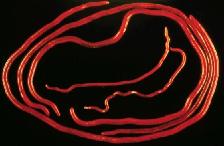 Most round worms fall into the phylum Nematoda. These worms do not come in segments, but are thread-like or vermiform (worm-shaped). These worms are common and live all over the world
Most round worms fall into the phylum Nematoda. These worms do not come in segments, but are thread-like or vermiform (worm-shaped). These worms are common and live all over the world
All of these worms are quite a bit longer than they are wide. They are pointed at both ends, and the male and female of the species are separate. Often, females will be larger than the males. Occasionally, this is taken to the extreme. In the guinea worm, the female is about 120 cm (about 4 feet long!) and the male averages about 2.5 cm, or just over an inch.
Most roundworms are harmless. They live in the soil and help break down nutrients and help plants. These are known as free-living worms. The majority of roundworms are beneficial to humans.
In spite of that fact, it is estimated that 1/3 of all humans have roundworms as parasites. Some time ago, a few roundworms figured they could hitch a ride inside the intestines or other organs and get a free meal. This worked exceptionally well. The worms got food, shelter and transportation. The host may or may not have been harmed in the process. At least the worms are happy.
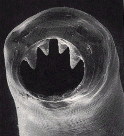 A common parasite is the Ascaris worm, or intestinal round worm. These spend part of their lives in the bodies of mammals, including humans. They set up shop in the intestines where the female turns into an egg-producing machine. A single female produces 200,000 eggs a day. No wonder at least 1 billion people on earth have these parasites.
A common parasite is the Ascaris worm, or intestinal round worm. These spend part of their lives in the bodies of mammals, including humans. They set up shop in the intestines where the female turns into an egg-producing machine. A single female produces 200,000 eggs a day. No wonder at least 1 billion people on earth have these parasites.
The Ascaris worm lays eggs in the intestine. They hatch, and the larva go into the bloodstream. There, they head for the lungs where they are coughed to the mouth. Once in the mouth, they are swallowed and return to the intestine. That's a long trip to end up right back where they started. It was worth it though. They meet, mate, and new eggs are shed in the feces (poop).
Usually, these worms don't cause death, but they will at times. A severe infestation may block the intestines. Also, if enough larvae can get into the lungs via the bloodstream, it may cause respiratory disease. Other parasitic round worms, called hookworms include Ancylostoma and Necator. These are tropical and semi-tropical.
One roundworm parasite which is familiar to Americans is the pinworm. While nasty to think about, these are just pests, and are not fatal. They are common, especially in children. If you want to avoid infection, you need to do all the things you've heard growing up:- Bathe or shower every day
- Put on fresh (clean) underwear every day
- Let some light into your room (eggs are sensitive to sunlight)
- Wash your hands after going to the toilet, before eating and after changing diapers
- Keep your fingernails trimmed
- Don't bite your nails
- Don't scratch your hind-end
Seems like Mom knew a thing or two, right?
Another worm to note is trichinella. This worm causes trichinosis, a disease usually caused by eating undercooked pork. The worm forms cysts in pork muscle which, if eaten, will grow to adults inside a human host. Meat inspection has helped reduce this disease in the U.S., but it's always best to cook meats (especially pork) completely.
Flat Worms
In Latin, the word helminthes means worm. The word platy means flat. Put them all together and you have Platyhelminthes or flat worms. So far so good, right? We're done talking about round worms, and now we've got the platyhelminths to deal with.
I'm sure you can give me a description of what they look like already. They're worm shaped (vermiform) and flat. Some have eyes. Some have eccentric mouths. Other than that, they're just flat worms.
 Some flatworms are marine, and are quite happy to live free in their ocean home. The largest free-living class is the Turbellaria. They often have beautiful colors and graze along the ocean floor. Turbellaria also includes some fresh-water flatworms called planaria. These worms eat dead or decaying matter in the waters and are very beneficial. Some even border on being cute. Planarians have a simple body plan with two large eye-spots. These are located in the head region which contains a rudimentary brain.
Some flatworms are marine, and are quite happy to live free in their ocean home. The largest free-living class is the Turbellaria. They often have beautiful colors and graze along the ocean floor. Turbellaria also includes some fresh-water flatworms called planaria. These worms eat dead or decaying matter in the waters and are very beneficial. Some even border on being cute. Planarians have a simple body plan with two large eye-spots. These are located in the head region which contains a rudimentary brain.
Planarians have no anus, but they have developed an interesting excretory system. They have flame cells, which are almost kidney-like in their regulation of what leaves the body. Planarians also have the ability to regrow lost parts, making them a fun study in many science classes. With a sharp enough blade, you can cause a planarian to grow a second head.
Planaria are also hermaphrodites. They have both male and female sex organs. When two planaria get together, both get their eggs fertilized. That's convenience.
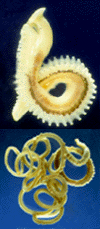 Not all flatworms are as docile as the planaria though. Let's save the big meanie for last and talk about flukes first. The flukes belong in one of two classes - Monogenea or Trematoda. These flukes are parasites, but most don't really want to be in a human. All the Monogeneans hang around fish. Most Trematodes prefer fish, turtles or mollusks. Most flukes are host-specific, meaning they only infest one or two species. The liver fluke is a nasty parasite of livestock. The flukes alternate hosts between mammals and snails.
Not all flatworms are as docile as the planaria though. Let's save the big meanie for last and talk about flukes first. The flukes belong in one of two classes - Monogenea or Trematoda. These flukes are parasites, but most don't really want to be in a human. All the Monogeneans hang around fish. Most Trematodes prefer fish, turtles or mollusks. Most flukes are host-specific, meaning they only infest one or two species. The liver fluke is a nasty parasite of livestock. The flukes alternate hosts between mammals and snails.
The blood fluke is a human parasite. It causes a disease which is fun to say, but not fun to have - schistosomiasis. The larval worms can burrow into the skin and get into the bloodstream of humans. The first symptoms are called swimmers itch, but itching may ot be present. The worms then head for specific organs. Some target the bladder, causing inflamation and blood in the urine. Some go toward the large intestine or liver, causing serious internal bleeding. If not treated, death is often the result.
Fortunately for you and me, this is mostly a tropical disease. Most local flukes trouble other mammals. One way to limit the number of flukes in a system is to get rid of snails. Most parasitic flukes uses snails as an intermediate host. They leave the snail at the larval stage to enter mammals, so if there were no snails there, there could be no flukes.
Ya know, that's one disadvantage of being a parasite. If the host is eliminated, you're pretty much toast.
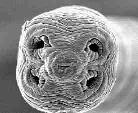 I commend you for making it this far without getting nauseous, but I can't promise you'll enjoy the Cestoda, or parasitic, tapeworms.
I commend you for making it this far without getting nauseous, but I can't promise you'll enjoy the Cestoda, or parasitic, tapeworms.
Ya know, I really don't like these invertebrates.
The class Cestoda has pared life down to the basic necessities. It is adept at both acquiring food and reproducing. For both, it hitches a ride along the intestinal wall of a mammal.
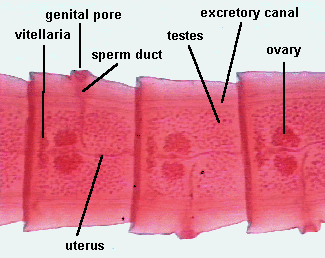 A tapeworm is comprised of a head and a sectional body. The head contains a scolex, or complex attachment device. The scolex is designed to attach to the host intestine and the tapeworm can absorb the nutrients directly through the skin, or cuticle. They do a good job at this. They don't need to slurp or even have a stomach. Their digestion is performed by the host.
A tapeworm is comprised of a head and a sectional body. The head contains a scolex, or complex attachment device. The scolex is designed to attach to the host intestine and the tapeworm can absorb the nutrients directly through the skin, or cuticle. They do a good job at this. They don't need to slurp or even have a stomach. Their digestion is performed by the host.
The remainder of the tapeworm only has one job - reproduction. A tapeworm is divided into sections called proglottids. Each section has both male and femal reproductive units. This can be seen in the picture, but you may need a larger version to see details.
A tapeworm may be as long as 30 feet, and more than 29 of those feet are the proglottids. A tapeworm can fertilize its own proglottid. The proglottid may then lay eggs which are passed via the feces to the outside world. An intermediate host then consumes them, and the larval worm makes a cyst in the muscle (meat) of the animal.
For humans, most tapeworm comes from beef or pork. Humans consume the infested meat and get a tapeworm. The tapeworm grows in the intestine where it reaches maturity. Eggs are shed in the feces, as well as whole proglottids. If this feces winds up in the soil, it can continue the cycle.
By the way, tapeworms become less appealing the more you know. Howevery, you may be interested in a strange website regarding tapeworms, or an icky pictures of tapeworms. If you would like to know more, feel free, but I may question your sanity.
Segmented worms
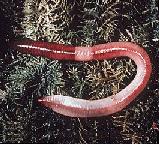 Congratulations, you've made it through the most dangerous of the worms to the annelids. Annelids (from the phylum Annelida) are all segmented worms, which means their bodies come in sections. This allows for more muscle control and is an advancement toward complete organ systems.
Congratulations, you've made it through the most dangerous of the worms to the annelids. Annelids (from the phylum Annelida) are all segmented worms, which means their bodies come in sections. This allows for more muscle control and is an advancement toward complete organ systems.
Annelids differ from the other words in haveing a complete intestinal tract with all the right tissues in all the right places. Most annelids are free-living, with only one notable critter which bothers humans. Almost all annelids are considered beneficial and do a great job at renewing and aerating soil.
The most familiar of the annelids is the common earthworm. These worms have done a lot for the rest of the world. Most likely, the world wouldn't be as productive and full of life is there weren't these organisms to stir up the soil a bit.
Worms have a remarkably complex anatomy for such little guys. They have all of the same body systems we have with two notable exceptions. Although they have nerves, they have no spinal cord, and (of course) they have no skeleton. They are amazingly complex though. They have a primitive heart - or rather - five pair of them.
Earthworms are hermaphrodites and both woorms that couple up can lay eggs after getting together. Some worms also can, under the right conditions, reproduce asexually.
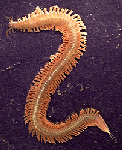 A close relative of the earthworms are the polychaetes (pronounced "Polly Keats"). These are better known as bristle worms. Annelids have setae, or bristle-like hairs which kinda work like feet. These setae help them move in the soil. In the polychaetes, these setae are very noticable and look like legs. Some polychaetes look more like millipedes or centipedes than worms, but they're worms anyway.
A close relative of the earthworms are the polychaetes (pronounced "Polly Keats"). These are better known as bristle worms. Annelids have setae, or bristle-like hairs which kinda work like feet. These setae help them move in the soil. In the polychaetes, these setae are very noticable and look like legs. Some polychaetes look more like millipedes or centipedes than worms, but they're worms anyway.
Most polychaetes are marine, but there are some freshwater species as well. None are parasitic to humans, but some are toxic. You shouldn't handle a polychaete worm unless certain.
There are polychaetes which look more like anemones or plants than worms. Notable are the Christmas tree worms and feather duster worms. Make sure you take a look at some.
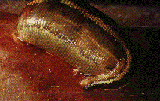 The only annelid which really bothers some people is the leech. Leeches have suction devices on each end so it can firmly hang on to the host. The leech then bites the prey. Leech saliva contains an analgesic (pain-killing) substance in it. Most people don't know they have a leech attached unti lthey see it. Leech saliva also contains an anti-coagulant, or blood thinner. This keeps the blood flowing until the leech has had its fill.
The only annelid which really bothers some people is the leech. Leeches have suction devices on each end so it can firmly hang on to the host. The leech then bites the prey. Leech saliva contains an analgesic (pain-killing) substance in it. Most people don't know they have a leech attached unti lthey see it. Leech saliva also contains an anti-coagulant, or blood thinner. This keeps the blood flowing until the leech has had its fill.
Although most annelids have setae, or bristles, leeches don't. They're uncharacteristically smooth. They don't live in the soil (usually) and so they don't need the bristles to move.
Leeches generally don't want to attach themselves to people. They would prefer a critter they can liquify a little more fully. Blood alone makes for a poor meal. In many ponds, there are numbers of leeches, but only a few times where thy'll bother people.
If you ever have a leech on you, don't yank it off. Irritate it until it detaches on its own. Use salt or something hot to convince it to go away. If you yank a leech, you may leave mouthparts attached to you, increasing your risk of infection.
In the middle ages, people used leeches to withdraw "bad blood" from people. Recently, leeches are being used again in medicine to control swelling and keep circulation going during some delicate surgeries. The anti-coagulant in leeches is being studied for medical purposes. The computer industry has also benefitted from leeches. They use leech neurons to try to create artificial intelligence.
All the way back to the animal page,
see sponges,
near the cnidarians,
meet the mollusks,
advance to the arthropods,
enquire about the echinoderms,
commune with the chordates or
over to the overview.
 What can I say - this page is about worms. It's not always pleasant, not always exciting, but worms are animals too.
What can I say - this page is about worms. It's not always pleasant, not always exciting, but worms are animals too. Most round worms fall into the phylum Nematoda. These worms do not come in segments, but are thread-like or vermiform (worm-shaped). These worms are common and live all over the world
Most round worms fall into the phylum Nematoda. These worms do not come in segments, but are thread-like or vermiform (worm-shaped). These worms are common and live all over the world A common parasite is the Ascaris worm, or intestinal round worm. These spend part of their lives in the bodies of mammals, including humans. They set up shop in the intestines where the female turns into an egg-producing machine. A single female produces 200,000 eggs a day. No wonder at least 1 billion people on earth have these parasites.
A common parasite is the Ascaris worm, or intestinal round worm. These spend part of their lives in the bodies of mammals, including humans. They set up shop in the intestines where the female turns into an egg-producing machine. A single female produces 200,000 eggs a day. No wonder at least 1 billion people on earth have these parasites. Some flatworms are marine, and are quite happy to live free in their ocean home. The largest free-living class is the Turbellaria. They often have beautiful colors and graze along the ocean floor. Turbellaria also includes some fresh-water flatworms called planaria. These worms eat dead or decaying matter in the waters and are very beneficial. Some even border on being cute. Planarians have a simple body plan with two large eye-spots. These are located in the head region which contains a rudimentary brain.
Some flatworms are marine, and are quite happy to live free in their ocean home. The largest free-living class is the Turbellaria. They often have beautiful colors and graze along the ocean floor. Turbellaria also includes some fresh-water flatworms called planaria. These worms eat dead or decaying matter in the waters and are very beneficial. Some even border on being cute. Planarians have a simple body plan with two large eye-spots. These are located in the head region which contains a rudimentary brain.  Not all flatworms are as docile as the planaria though. Let's save the big meanie for last and talk about flukes first. The flukes belong in one of two classes - Monogenea or Trematoda. These flukes are parasites, but most don't really want to be in a human. All the Monogeneans hang around fish. Most Trematodes prefer fish, turtles or mollusks. Most flukes are host-specific, meaning they only infest one or two species. The liver fluke is a nasty parasite of livestock. The flukes alternate hosts between mammals and snails.
Not all flatworms are as docile as the planaria though. Let's save the big meanie for last and talk about flukes first. The flukes belong in one of two classes - Monogenea or Trematoda. These flukes are parasites, but most don't really want to be in a human. All the Monogeneans hang around fish. Most Trematodes prefer fish, turtles or mollusks. Most flukes are host-specific, meaning they only infest one or two species. The liver fluke is a nasty parasite of livestock. The flukes alternate hosts between mammals and snails. I commend you for making it this far without getting nauseous, but I can't promise you'll enjoy the Cestoda, or parasitic, tapeworms.
I commend you for making it this far without getting nauseous, but I can't promise you'll enjoy the Cestoda, or parasitic, tapeworms.  A tapeworm is comprised of a head and a sectional body. The head contains a scolex, or complex attachment device. The scolex is designed to attach to the host intestine and the tapeworm can absorb the nutrients directly through the skin, or cuticle. They do a good job at this. They don't need to slurp or even have a stomach. Their digestion is performed by the host.
A tapeworm is comprised of a head and a sectional body. The head contains a scolex, or complex attachment device. The scolex is designed to attach to the host intestine and the tapeworm can absorb the nutrients directly through the skin, or cuticle. They do a good job at this. They don't need to slurp or even have a stomach. Their digestion is performed by the host. Congratulations, you've made it through the most dangerous of the worms to the annelids. Annelids (from the phylum Annelida) are all segmented worms, which means their bodies come in sections. This allows for more muscle control and is an advancement toward complete organ systems.
Congratulations, you've made it through the most dangerous of the worms to the annelids. Annelids (from the phylum Annelida) are all segmented worms, which means their bodies come in sections. This allows for more muscle control and is an advancement toward complete organ systems. A close relative of the earthworms are the polychaetes (pronounced "Polly Keats"). These are better known as bristle worms. Annelids have setae, or bristle-like hairs which kinda work like feet. These setae help them move in the soil. In the polychaetes, these setae are very noticable and look like legs. Some polychaetes look more like millipedes or centipedes than worms, but they're worms anyway.
A close relative of the earthworms are the polychaetes (pronounced "Polly Keats"). These are better known as bristle worms. Annelids have setae, or bristle-like hairs which kinda work like feet. These setae help them move in the soil. In the polychaetes, these setae are very noticable and look like legs. Some polychaetes look more like millipedes or centipedes than worms, but they're worms anyway. The only annelid which really bothers some people is the leech. Leeches have suction devices on each end so it can firmly hang on to the host. The leech then bites the prey. Leech saliva contains an analgesic (pain-killing) substance in it. Most people don't know they have a leech attached unti lthey see it. Leech saliva also contains an anti-coagulant, or blood thinner. This keeps the blood flowing until the leech has had its fill.
The only annelid which really bothers some people is the leech. Leeches have suction devices on each end so it can firmly hang on to the host. The leech then bites the prey. Leech saliva contains an analgesic (pain-killing) substance in it. Most people don't know they have a leech attached unti lthey see it. Leech saliva also contains an anti-coagulant, or blood thinner. This keeps the blood flowing until the leech has had its fill.